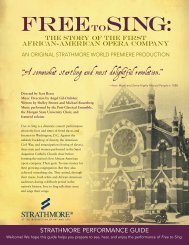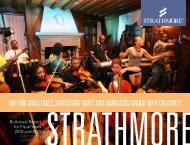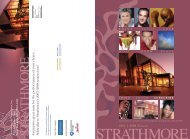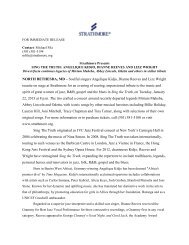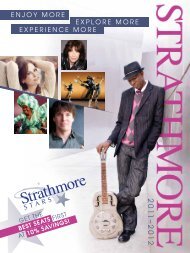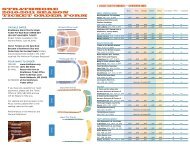meet arthur's friends 4 - Strathmore
meet arthur's friends 4 - Strathmore
meet arthur's friends 4 - Strathmore
You also want an ePaper? Increase the reach of your titles
YUMPU automatically turns print PDFs into web optimized ePapers that Google loves.
WELCOME!<br />
2<br />
Welcome to the performance of Arthur Live! We’re<br />
delighted that you’ve chosen this show to introduce young<br />
people to the magic of live theater.<br />
These Keynotes provide information and activities that<br />
will help you prepare your children for the performance and<br />
then reflect on what they’ve seen and heard in the show.<br />
With younger children, we encourage you to read the<br />
information to them and facilitate the activities. This guide<br />
also contains reproducible activity pages that can be used<br />
with even the youngest children.<br />
CONTENTS<br />
Welcome/Acknowledgements..........................................................2<br />
About the Show ....................................................................................3<br />
Meet Arthur’s Friends ..........................................................................4<br />
Meet the Author ....................................................................................5<br />
Open Wide!..............................................................................................6<br />
Activity Ideas ..........................................................................................7<br />
Activity Page: My Family and Friends ............................................8<br />
Activity Page: Tooth Fairy Fun ..........................................................9<br />
Activity Page: Good Food, Good Teeth ......................................10<br />
Animal Teeth ........................................................................................11<br />
Activity Page: Animal Worksheet ..................................................12<br />
Activity Page: What’s My Job at the Show? ..............................13<br />
Resources................................................................................................14<br />
Keynotes are made possible by a<br />
generous grant from Bank of<br />
America Charitable Foundation.<br />
The State Theatre’s education program is funded in part by Bank of America Charitable Foundation,<br />
Bristol-Myers Squibb, Brother International Corporation,The Horizon Foundation for New Jersey,<br />
Johnson & Johnson Family of Companies, the John F. Kennedy Center for the Performing Arts, J. Seward<br />
Johnson, Sr. 1963 Charitable Trust, The Blanche and Irving Laurie Foundation, McCrane Foundation,<br />
MetLife Foundation, Mid Atlantic Arts Foundation, National Starch and Chemical Foundation, Inc., PNC<br />
Foundation, Provident Bank Foundation, Robert Wood Johnson Foundation, Verizon, and Wachovia<br />
Foundation. Their support is gratefully acknowledged.<br />
Funding has been made possible in part by<br />
the New Jersey State Council on the<br />
Arts/Department of State, a partner agency<br />
of the National Endowment for the Arts.<br />
Continental Airlines is the official<br />
airline of the State Theatre.<br />
Keynotes are produced by the Education<br />
Department of the State Theatre, New Brunswick, NJ.<br />
Wesley Brustad, President<br />
Lian Farrer, Vice President for Education<br />
Keynotes for Arthur—Live!<br />
Written and designed by Katie Pyott<br />
Edited by Lian Farrer<br />
© 2007 State Theatre<br />
Arthur Live! is produced by Turnstile Presents, Inc.<br />
The State Theatre, a premier nonprofit venue for<br />
the performing arts and entertainment.
ABOUT THE SHOW<br />
3<br />
Arthur Live! is adapted from the animated<br />
TV series broadcast on PBS KIDS, and based<br />
on Marc Brown’s best-selling book series.<br />
The performance brings to life all the<br />
series’ favorite characters: Arthur’s family,<br />
Buster, Francine, Binky, Muffy, and Pal.<br />
The show includes songs, dances, and<br />
audience participation. This show is<br />
based on the book entitled Arthur<br />
Tricks the Tooth Fairy.<br />
<br />
Arthur is the star of the show. His full name is<br />
Arthur Timothy Read, and he lives in Elwood City<br />
with his mom, dad, and two sisters. The most<br />
important thing about Arthur is that he actively<br />
explores the world around him.<br />
<br />
D.W. is jealous when her big brother Arthur loses a tooth and gets<br />
money from the Tooth Fairy. Arthur explains that the Tooth Fairy comes<br />
only when you lose a tooth and put it under your pillow at night. D.W.<br />
dreams up some hysterical (but unsuccessful) plans to trick the Tooth Fairy<br />
into paying her a visit. Ultimately, Arthur decides to reward D.W.’s efforts by<br />
playing Tooth Fairy himself!<br />
<br />
• Getting along with an older or younger brother or sister<br />
• Stages of development: everyone grows on his or her own schedule.<br />
EXPLORING THE<br />
THEMES<br />
<br />
<br />
<br />
<br />
<br />
<br />
<br />
<br />
<br />
<br />
<br />
<br />
<br />
<br />
<br />
<br />
<br />
<br />
<br />
<br />
• Baby teeth/adult teeth; taking care of your teeth<br />
• Different animals and their different sized/shaped teeth
MEET ARTHUR’S FRIENDS<br />
4<br />
D.W. (short for Dora Winifred) is Arthur’s<br />
little sister. She’s bossy, independent, and a<br />
little dramatic. While she loves to bug<br />
Arthur, she is also very loyal to him.<br />
ASK YOUR STUDENTS<br />
<br />
<br />
<br />
<br />
Baby Kate is the youngest member of the<br />
Read family. As an infant, she makes messes<br />
and odd noises. Through her, Arthur and<br />
D.W. learn how to be good older siblings.<br />
<br />
<br />
<br />
<br />
<br />
<br />
<br />
<br />
<br />
Pal is Arthur’s dog. Through him, Arthur<br />
gains responsibility and companionship.<br />
<br />
<br />
<br />
<br />
<br />
Buster Baxter is Arthur’s best friend. He’s a<br />
sociable kid who loves to eat and tell jokes,<br />
and has a hard time motivating himself to<br />
do homework. Buster has asthma, but it<br />
doesn’t stop him from being active.<br />
<br />
<br />
<br />
<br />
<br />
<br />
<br />
<br />
<br />
<br />
<br />
<br />
Brain (whose real name is Alan) is a friendly<br />
kid who takes his enormous intellect in<br />
stride. While he’s smart, he’s not a “know-itall.”<br />
He has a great interest in sports, and is<br />
especially skilled at soccer.<br />
Francine Frensky is an explorer and a doer.<br />
She’s sometimes overly confident and<br />
competitive, but she is a good and loyal<br />
friend. She loves sports and playing drums.<br />
“FRIENDLY” FUN<br />
<br />
<br />
<br />
<br />
“”
MEET THE AUTHOR<br />
5<br />
Best known as the creator of Arthur, author/illustrator<br />
Marc Brown has been working with the beloved aardvark<br />
for over 25 years. Born one night when Brown was<br />
telling a bedtime story to his son, Arthur soon evolved<br />
into the book Arthur’s Nose, published in 1976. Since<br />
then, Brown has written and illustrated more than 30<br />
Arthur and D.W. books, and has illustrated many<br />
other books—including one with his wife,<br />
author/illustrator and psychologist Laurie Krasny<br />
Brown.<br />
Most of the characters in Marc Brown’s books are<br />
modeled after one person or a combination of people from his life. Many<br />
characters were inspired by people he knew when he was growing up and going to school in Milcreek,<br />
Pennsylvania. Mr. Ratburn is based on the “meanest algebra teacher ever,” and Grandma Thora is based<br />
on Brown’s real grandmother Thora, “the best storyteller ever.” Says Brown, “Buster is modeled after my<br />
best friend in elementary school, Terry Johnson, who was a real practical joker. Terry spent a lot of time in<br />
the principal’s office. In third grade, I spent a lot of time watching a girl named Patricia DelPorto instead<br />
of doing my math. She had curly hair and long eyelashes. On Valentine’s Day, I remember waiting to get<br />
a valentine from her. She is, of course, Sue Ellen, and that’s where I got the idea for Arthur’s Valentine.”<br />
Brown’s sisters—Bonnie, Colleen, and Kimberly—have all served as role models for characters in his<br />
books, especially for D.W. and Francine.<br />
As for story ideas, Marc Brown looks for inspiration to his own three children: Tolon, Tucker, and Eliza.<br />
He also gets many suggestions from children he <strong>meet</strong>s in schools, libraries, and bookstores around the<br />
country. “The most interesting—and the funniest—things,” Brown says, “happen in real life.”<br />
Information taken from www.pbskids.org and www.kidsreads.com.<br />
FOR DISCUSSION:
OPEN WIDE!<br />
6<br />
TOOTH ANATOMY<br />
The part of the tooth above the gums is called<br />
the crown. Below the gums are the roots. The<br />
crown is covered with a hard white surface<br />
called enamel. It is the hardest material made by<br />
the body. It protects the inner tooth from germs<br />
and bacteria. Beneath the enamel is the dentin. It<br />
is not very hard. In the center of the tooth is the<br />
pulp. This is where all the nerves and blood<br />
vessels are. The pulp is the part that hurts when<br />
you have a toothache.<br />
<br />
<br />
<br />
<br />
<br />
<br />
BABY TEETH<br />
By the time they are 3 years old, most children have a full set of 20 baby, or primary, teeth. (Adults have<br />
32 teeth.) Around the age of 5 to 7, the first baby tooth falls out, usually a front tooth, top or bottom. A<br />
permanent tooth soon takes its place. Around age 7 or 8, children<br />
lose the two teeth on either side. Between the ages of 9 and 12,<br />
children lose their pointed canine teeth and their first and second<br />
molars.<br />
<br />
<br />
HOW CAVITIES ARE FORMED<br />
Cavities are caused by sugars left on teeth after meals or<br />
snacks. Bacteria feast on these sugars and form acid as a byproduct.<br />
This acid eats into the tooth enamel, eventually<br />
creating a cavity. One way to prevent cavities is to limit<br />
between-meal snacks. If you need a snack, choose raw<br />
vegetables, fruit, or cheese.<br />
<br />
<br />
<br />
<br />
CLEAN, HEALTHY TEETH<br />
Brush your teeth as soon as possible after eating. Removing all<br />
food particles from your teeth prevents decay. Children should<br />
be encouraged to brush their own teeth from an early age, but<br />
an adult should rebrush the child’s teeth until he or she is 5 or<br />
6, to ensure a thorough cleaning. Many dentists recommend<br />
that parents also help their children learn to floss. Children and<br />
adults should visit a dentist twice a year for a checkup and<br />
teeth cleaning.
ACTIVITY IDEAS<br />
7<br />
HOW MANY TEETH?<br />
<br />
<br />
BABY TEETH<br />
<br />
<br />
<br />
<br />
<br />
<br />
WHEN I WENT TO THE DENTIST...<br />
<br />
<br />
<br />
<br />
TOOTHPASTE SURVEY<br />
<br />
<br />
<br />
<br />
<br />
<br />
<br />
<br />
<br />
<br />
<br />
DENTISTS IN THE<br />
CLASSROOM
MY FAMILY AND FRIENDS<br />
8
TOOTH FAIRY FUN<br />
9<br />
<br />
<br />
<br />
THIS BAG<br />
HOLDS<br />
TEETH.
GOOD FOOD, GOOD TEETH<br />
10<br />
<br />
<br />
<br />
<br />
Good for My Teeth<br />
Bad for My Teeth
ANIMAL TEETH<br />
11<br />
<br />
<br />
<br />
<br />
<br />
THE TOOTH OF THE MATTER<br />
<br />
<br />
SHARKS lose teeth each week.<br />
They get new teeth when<br />
they lose the old ones. They<br />
can have over 20,000 teeth in a lifetime.<br />
<br />
CROCODILES have 60 teeth<br />
in their mouth at a time.<br />
They can grow up to 2-3,000<br />
teeth during their lifetime.<br />
<br />
Some SNAKES have hollow teeth called fangs<br />
that contain poison.<br />
<br />
<br />
ELEPHANTS have four sets<br />
of teeth in their lifetime.<br />
Their tusks are the<br />
longest teeth in the world.<br />
<br />
<br />
DOLPHINS have more teeth<br />
than any other animal.<br />
Some dolphins have over 200<br />
teeth. Scientists can tell the age of a dolphin by<br />
the rings on her teeth.<br />
<br />
SNOWSHOE RABBITS fight<br />
with their teeth. Adult males<br />
use their teeth to fight one<br />
another for the females.<br />
<br />
<br />
GIRAFFES have 32 teeth, just like humans.<br />
<br />
BALEEN WHALES don’t have teeth. They have<br />
stiff plates, made of the same material as human<br />
hair and fingernails. These plates hang down<br />
from the upper jaw and<br />
trap small fish and other<br />
food.
ANIMAL WORKSHEET<br />
12
WHAT’S MY JOB AT THE SHOW?<br />
13<br />
<br />
<br />
<br />
<br />
<br />
When I go to a , I am part of the . This is a<br />
very important job. I have to and carefully.<br />
If I talk or move around, the actors and the<br />
will have a<br />
hard time paying attention to the .<br />
When the is over, it’s okay for me to .
RESOURCES<br />
14<br />
INTERNET<br />
American Dental Association<br />
www.ada.org<br />
Arthur book series website<br />
www.randomhouse.com/kids/ arthur<br />
Arthur television show website, with sections<br />
for parents and teachers<br />
http://pbskids.org/arthur<br />
Marc Brown<br />
www.marcbrownstudios.com<br />
Dental hygiene tips<br />
www.toothfairy.org<br />
VIDEO<br />
Arthur’s Missing Pal. Lions Gate Films, 2006. DVD. rated G<br />
Arthur’s Tooth. Sony Wonder Video, 2005. DVD. not rated<br />
Open Wide, Tooth School Inside...and 4 More Fantastic Children’s Stories.<br />
Scholastic Video Collection, 2007. DVD. not rated<br />
BOOKS<br />
Arthur’s Tooth, by Marc Brown, LB Kids, 2005<br />
Arthur Tricks the Tooth Fairy, by Marc Brown, Random<br />
House, 1997<br />
How Many Teeth?, by Paul Showers. HarperTrophy. 1991<br />
Open Wide: Tooth School Inside, by Laurie Keller,<br />
Owlet, 2003<br />
Throw Your Tooth on the Roof: Tooth Traditions<br />
from Around the World, by Selby Beeler, illustrated<br />
by G. Brian Karas. Houghton Mifflin, 2001<br />
What Big Teeth You Have!, by Patricia Lauber. Scholastic<br />
Book Services, 1993<br />
What Do the Fairies Do with All Those Teeth?, by Michel<br />
Luppens, Firefly Books, 1996






